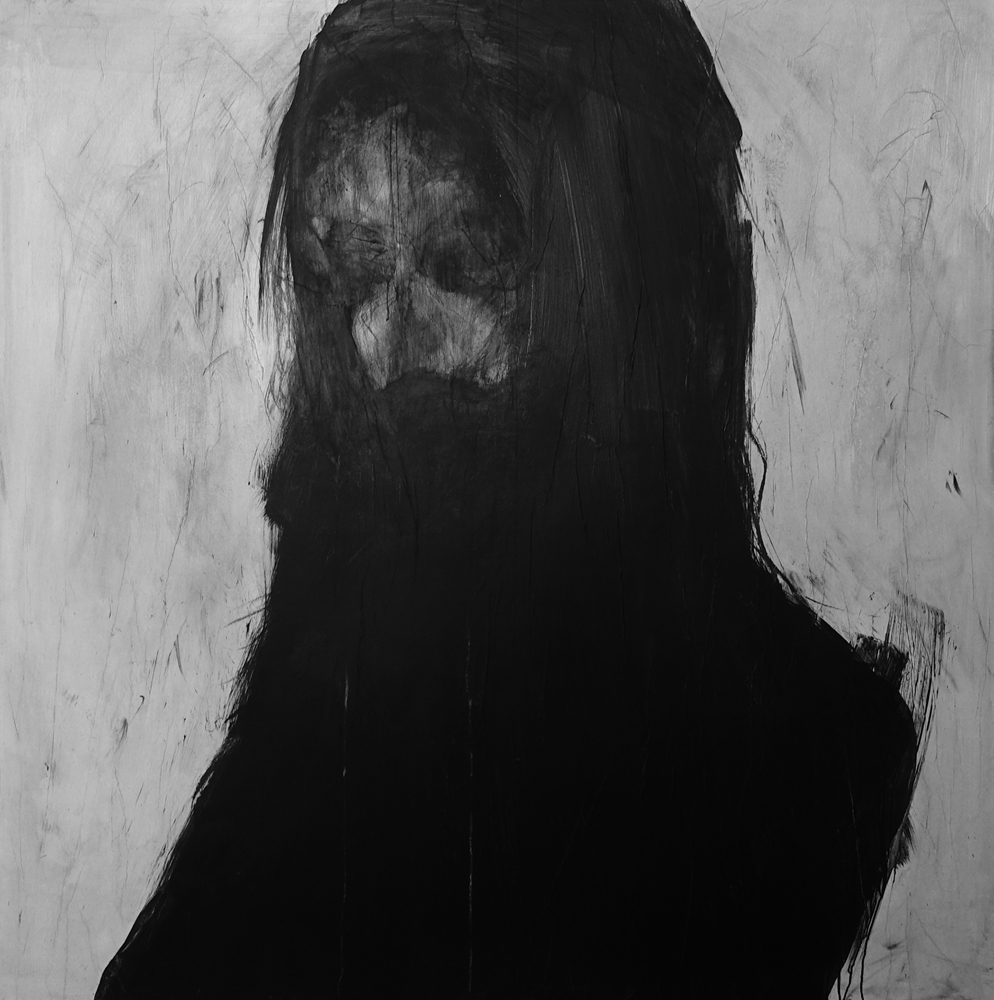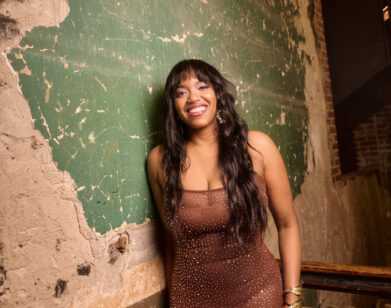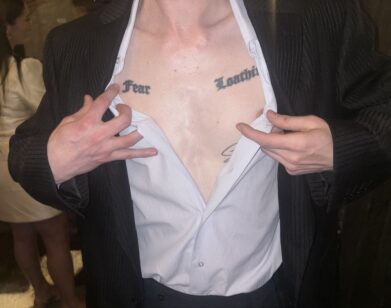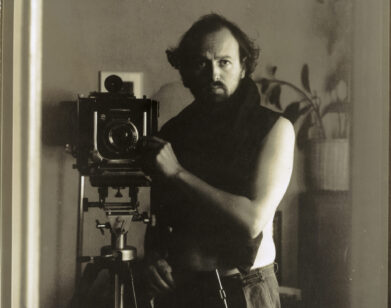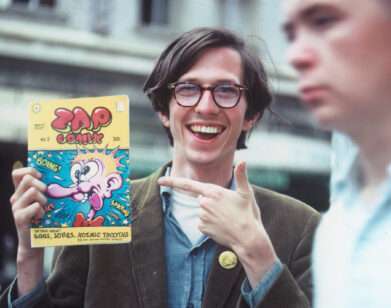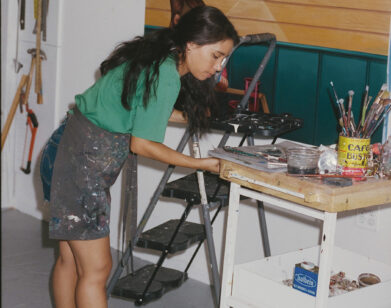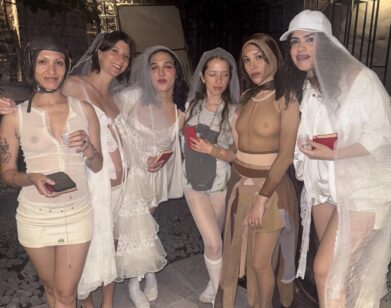Jesse Draxler Embraces Mortality
JESSE DRAXLER IN NEW YORK, JANUARY 2016. PORTRAIT: MARK DAVIS.
Through his exploration of an unknown past, daunting yet exciting future, and rather stagnant present, artist Jesse Draxler’s large-scale collage works draw the viewer in while simultaneously causing shock and a feeling of disturbance. Digital inversions and hand painted alterations obscure faces rendered only in black-and-white; faceless figures embody universal notions of death and terror, yet to Draxler, they also act as self-portraits. In the Los Angeles-based artist’s first New York solo show “Terror Management™,” which is currently on view at Manhattan’s Booth Gallery, he draws heavily from the notion that everything a human does is influenced by the inevitable fact that one day everyone dies.
Within the show, certain patterns that Draxler has previously explored reappear: there are three new works for his “Fucked Up Chuck Close” series, all of which obscure Close’s iconic Big Self-Portrait (1967-1968) on a Walker Art Center poster; there is a continuation of his “Joke Painting” series, consisting of rice paper painted with sentences like “Richard Prince of Bel Air” and “Richard Prince of Piss.” Previously unseen concepts are also presented, including more conceptual works like No Thought, a panel depicting a blackened silhouette of Rodin’s The Thinker, as well as the show’s singular sculpture Black Mail. Atop of a pedestal sits a pile of Draxler’s student loan bills that he painted black. According to the gallery’s director and curator Casey Gleghorn, “part of the concept is that the buyer has to take over the price of the student loan bills for $100,000.”
Before living in L.A., the Wisconsin native received his BFA from the College of Visual Arts in St. Paul, Minnesota. He now creates daunting self-portrait and conceptual works like those in “Terror Management™” as well as commissions for publications like The New York Times and fashion brands. For example, in April, McQ by Alexander McQueen will debut a new collection and campaign composed of Draxler’s collage work. Though some pieces take a matter of days to physically complete, when we meet the artist at Booth Gallery, he says, “I spend a lot of time writing and journaling. To me, the inception starts with thinking about it or processing an idea in my mind. So they all took my entire fucking life to make.”
EMILY MCDERMOTT: The title of the show, “Terror Management™,” comes from the book The Worm at the Core. Can you tell me about the book and how you first encountered it?
JESSE DRAXLER: It’s a scientific exploration of what our knowledge of mortality does to our psyche. Basically, it says that everything we do in life, on every level, is at the core influenced by the idea that we’re going to die someday. It’s something that I’ve researched a lot, but I had never found a scientific exploration of it. It’s always an emotive or philosophical way of writing, so a scientific exploration was really refreshing—straight facts and research. I first came across it midsummer last year. My friend Greg Puciato, from Dillinger Escape Plan, we have a lot in common, so we were exchanging books and he told me to check it out.
MCDERMOTT: The explanation of the show also says that it deals with your unknown past, a daunting but exciting future, and a stale present. Can you expand upon that?
DRAXLER: I had some traumatic experiences in my past and it caused me to create a lot of blocks in my memory, where I don’t remember my childhood clearly at all. There’s no real record and my family doesn’t talk about it, so I don’t fully understand or know what happened. It makes it this unknown in my life, this blank space, which is a weird thing to deal with. That’s really influential in my work, the idea of an unknown.
MCDERMOTT: Would you consider your work as a therapeutic release or exploration of it?
DRAXLER: It’s an exploration of it, but I don’t feel like it’s therapy in any kind of way. I don’t know what I would be treating. It’s not therapeutic in a way like, “Oh this makes me feel better,” although it does make me feel better sharing the work…In hindsight, stepping into this gallery and seeing the work together, I see things that I didn’t see when I was working on them individually. This is a lot of work. It has a very daunting presence. It’s intense to see it all together.
MCDERMOTT: After you create the works, do you feel a certain kind of relief or does it just create more daunting thoughts because you’re going further and further into your head?
DRAXLER: If I like the piece, I’m like, “That’s fucking cool,” and it is a temporary release. But I don’t like my work for too long. I’m one of those people that makes a piece and week later I’m like, “I hate that shit.” If I really don’t like it, I’ll paint over it, start over.
When I was working on this show, after I finished a piece, I would leave it out in my studio for a day to decide whether or not it was completely finished, then I’d put the finishing touches—painting the sides and putting the clear coat on the top—and then I put it away. I turned them backwards to the wall. I put cloth over them so I couldn’t see them again. If I see them too much, I’ll hate them. I put them away so I don’t have the opportunity to hate them.
MCDERMOTT: Some artists, especially surrealist photographers like Herbert Bayer, used collaging to depict dreams and other worldly encounters. Do you ever think of your work as taking existing pieces of our world to create a new one?
DRAXLER: It’s tough to talk about my work in a generalized way, because I feel like there are two facets to it. There’s the conceptual work and then there’s the emotive work. The emotive work comes from a personal place and feelings. I do think of it as creating a world, but instead of the world, I’m creating the characters for the world. [The characters] are all me, they’re all self-portraits in a way. Every single one of them is untitled. When it comes to art, for me, the fewest amount of words around it as possible, the better. So many words have dual meanings, words can be mistaken in so many different ways, and I don’t want to leave that interpretation open.
MCDERMOTT: You do a lot of commissioned work as well. How do you merge it with or separate it from your personal work?
DRAXLER: A lot of people hire me for my personal vision and work. So with commissions, they’ll supply me with images, give me the starting point, and then I do whatever I want to it. I use those occasions of doing commissioned work to explore new media, new material, and new processes that I can use later in my fine artwork.
The digital stuff, for sure, came from [commissions]. An illustration has a lot of digital work, so I figured out how to use the digital media when I was doing those and then bridged it into my collages. There are digital starts and inversions of photos, even Telepathic Link to Hell has some digital elements because it was spray paint on velum, scanned in, traced out, reprinted. Using digital media has become important, but it doesn’t change my vision or what I do. It just opens up the territory. It’s another tool in my tool belt. The more things I’m capable of doing, the better I am at expressing my vision. So I’m constantly trying to learn new stuff.
MCDERMOTT: Going back to reading, what are other books or ideas that you find really inspiring? You also mentioned punk music…
DRAXLER: This last summer I really got into reading Alan Watts. He’s the white dude that bridged Zen philosophy into the Western world. I read a lot of Zen philosophy and that was really influential. Music is really influential and so are movies. I listen to music 10, 12 hours a day, all in my headphones when I’m working in the studio.
MCDERMOTT: Always through headphones?
DRAXLER: Yeah. For the last half of a year, since I got my new studio, my neighbor was complaining about my music, sliding notes under my door every other day. I was like, “Fuck this. I’m going to invest in some nice Bose Bluetooth headphones.” It was the best thing that’s ever happened to me, honestly.
MCDERMOTT: I see you have the Bluetooth logo tattooed behind your ear. Is that when you got it?
DRAXLER: I actually got that a long time ago. I love Bluetooth. But the headphones were a game changer. They really helped me zone in. It really erased the rest of the world and I got further into my bubble. That helps the work. But I like everything—metal, hardcore, techno, hip-hop, electronic…
MCDERMOTT: What about films, do you have certain directors you follow?
DRAXLER: I’m a really big fan of Alex Garland. It sounds like jumping on a bandwagon because of Ex Machina, that was the first movie he directed, but before Ex Machina he was a writer. He wrote The Beach, he did the screenplay for 28 Days Later, and he had a hand in Trainspotting; he worked a lot with Danny Boyle. I really loved him and I was reading his books. He’s a great author. Stanley Kubrick, obviously. I saw 2001 last summer at the big L.A. coliseum with a live orchestra. The movie I saw most recently that I liked was The Revenant. It’s brutal, but it’s gorgeous. The pano shots over landscapes were mind blowing.
MCDERMOTT: I want to go back to your childhood. I read that you never succeeded academically and always loved art class, but when did you first become interested in collage specifically?
DRAXLER: [laughs] Yes, I failed at pretty much every class except art. They finally gave up my senior year and said, “You don’t have to go to math, you can just be in the art room four periods of the day.” But I got into collage my senior year of art college. For my thesis paper, I wrote on the commodification of subculture aesthetic, using punk as a lens, and showing how punk was appropriated by mainstream culture as a way to show false authenticity. Through that and viewing a lot of punk work—all the band flyers and stuff—there was a lot of collage imagery. Collage was mainly their medium and I really liked it.
MCDERMOTT: Do you remember when you first started making art in general or seeing an artist and saying, “I want to try to emulate that?”
DRAXLER: I grew up in a really rural part of Wisconsin, so there were no museums, no galleries, nobody was talking about art, nobody was doing art. I first stepped in a real museum when I was 19, when I moved for art school. So I wasn’t really influenced by other artists until later in life. I do have a memory from childhood, it’s the only memory of art that I have: I used to draw a lot of trucks. My dad grew up as a mechanic. On his side of the family, they had an auto body, so I was into cars and trucks, and he was into cars and trucks. I used to draw trucks with my friends. We would have competitions of who could draw better trucks.
MCDERMOTT: So you moved to Minneapolis for art school when you were 19, then moved to L.A., but then back to Minneapolis, and now you’ve returned to L.A. Why so much back and forth?
DRAXLER: You really did do your research! [laughs] In 2014, I was in L.A. probably one quarter of the year. In January of 2015, I moved there. The first time I moved to L.A., I moved there for art reasons, but I wasn’t good enough. I had some shows, but it wasn’t what I wanted; I wasn’t at the point I wanted to be. I was also living with this girl and we didn’t work out. I was broke. I couldn’t do it. It just fell apart. So I moved back to Minneapolis, I started getting better at my craft and really figuring out what I was doing. Then Minneapolis, all of a sudden, felt like a wall. I was showing at the biggest galleries in Minneapolis and it wasn’t doing anything for my career. People would go to the show, say how great it was, but wouldn’t buy anything. It ended there. Nothing else came from it. Having a show in New York or L.A., people are connected to the world. You have a show in one of those cities and it spreads. In Minneapolis, it felt like a dead end.
MCDERMOTT: When you returned to Minneapolis because you weren’t happy with your work, what changes did you make? How did you know you were ready to go back to L.A.?
DRAXLER: The biggest shift was when I decided to cut out all color and only work in black and white. Things just started clicking like crazy. It was almost an audible explosion I could hear in my brain. There are many reasons [I left color behind], but Michelangelo said, “Beauty is the purgation of superfluities.” That’s a quote that I really love, that I’ve always understood deeply—cutting fat, getting down to the bare essence of things. For me, color was completely unnecessary so I just cut it out.
But also, I’m colorblind, technically color deficient. I can see color but it’s different, so it was always a pain in the ass working with color. I worked with colored pencils for a while and if I sharpened the wrong end and the name was gone, I was like, “Fuck. I have to throw this colored pencil away. I don’t know what it is.” Red could be brown, or brown could be red. Green was brown—that’s how I found out I was colorblind in first grade: I colored a horse green. I went to Catholic school for nine years, so I was taught by a nun and she wasn’t having it. The rest of the class laughed at me and thought I was being a jokster. I got in trouble. My parents brought me to a doctor and found out I was colorblind. It was legitimate that I thought I was coloring the horse brown, but it was green. So yeah, it was really easy for me to get rid of color. No love lost whatsoever.
MCDERMOTT: Why did you even work in color to begin with?
DRAXLER: Because everybody does. When you’re young and learning the ropes, you don’t think of it as an option to work solely in black and white. It didn’t even cross my mind. That’s why it was such a mind-blowing thing when I decided to cut it out.
MCDERMOTT: You also do a lot with fashion, like the upcoming collaboration with McQ. How do you feel about the fashion industry?
DRAXLER: We could talk about this for a long time. Most of this work started with fashion imagery and I started working with fashion imagery because there’s so much of it. It’s an over abundance and it’s so disposable, even to the photographers. After meeting photographers and working with them, seeing how many photos they take, how many they use, and then they’re on to another shoot the next day, these photos, as far as I can tell, mean nothing to them. A lot of the time I work directly with the photographer on the images from the inception. Some of it I just take out of magazines, and I love doing that, but sometimes the photographer will find out and be like, “That’s my photo!” and I’m like, “Fuck you.”
MCDERMOTT: But you’ve totally appropriated most the images. As you said, in some of them you can’t even recognize the original image.
DRAXLER: It’s a hot topic, the whole appropriate thing. That’s why I love Richard Prince. He gets sued all the time for appropriating images. I wouldn’t mind getting sued! [laughs] Richard Prince has a quote that speaks exactly to why I use it, because the original photos are all fake, they’re empty, there’s nothing to them. He said, “I seem to go after images that I don’t quite believe and I try to re-present them even more unbelievably.” The way I take that is like I don’t believe in these images. In a magazine, it’s like they’re trying to make this person look like a punk, but they’re actually in a studio and it is very thought out and expensive. You’re faking the funk, you know? That’s why I take it and make it real—or make it more unbelievable.
“TERROR MANAGEMENT™” WILL BE ON VIEW AT BOOTH GALLERY THROUGH FEBRUARY 20, 2016. FOR MORE ON JESSE DRAXLER, VISIT HIS WEBSITE.

